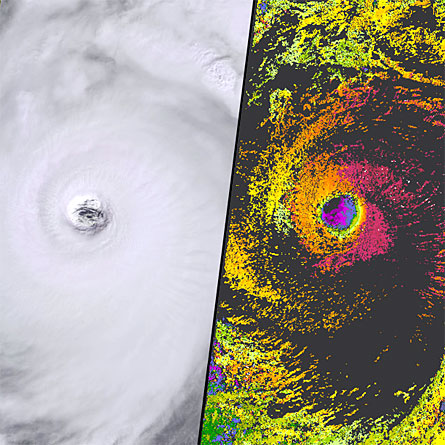Some of the world’s strongest storms, particularly North Atlantic hurricanes, have, on average, gained wind speed during the past three decades, thanks to a warming trend in many of the ocean basins where such storms are spawned.

New analyses reported in the Sept. 4 Nature indicate that in the strongest tropical cyclones — also known as hurricanes in the North Atlantic and typhoons in the North Pacific — peak wind speeds increased as much as 3 meters per second each decade from 1981 to 2006.
In other words, the strongest North Atlantic hurricanes in the 1990s had peak wind speeds about 10 kilometers per hour faster than those in the region’s strongest storms of the 1980s. Wind speeds measured for the largest storms from 2000 to 2006 were faster still, says James P. Kossin, an atmospheric scientist at the University of Wisconsin–Madison.
Using satellite observations of more than 2,000 tropical cyclones worldwide, Kossin and his colleagues estimated each cyclone’s peak winds by looking at the temperatures of the tallest clouds spotted during the storm’s lifetime. Previous research, including data gathered by instruments dropped from aircraft, has shown that the colder and higher the clouds, the faster the winds at ground level, Kossin says.
The researchers found that the largest increases in cyclone peak winds were in the North Atlantic and eastern North Pacific oceans, regions where sea surface temperatures had warmed from 1981 to 2006.
Cyclones are essentially heat engines that extract power from warm seas, says Kossin. The larger the temperature difference between the ocean surface and the upper atmosphere, the larger a cyclone can become, he notes.
The new study is the first to use the same analytical technique to examine cyclone activity in a number of ocean basins, says Peter J. Webster, an atmospheric scientist at Georgia Tech in Atlanta. The findings clarify and confirm the results of a more limited analysis he and his colleagues reported in 2005, he notes.
The new study is “further evidence for the effect of global warming on hurricane intensity,” says Kerry Emanuel, an atmospheric scientist at the Massachusetts Institute of Technology. Even though there hasn’t been a significant increase in the total number of tropical cyclones worldwide, the new research “offers definitive evidence that there are more of the very strongest hurricanes around the world,” he adds.
The strongest storms, which “used to be category 2 and 3 storms in the 1950s, are now category 4 and 5 storms,” agrees Judy Curry, an atmospheric scientist at Georgia Tech.
Some researchers, however, question the new findings. Chris Landsea, an atmospheric scientist at the NationalHurricaneCenter in Miami, notes that storm strength in the AtlanticBasin tends to fluctuate in cycles spanning many decades, a trend the new analysis doesn’t capture because its period of satellite observations is too short. Also, he notes, Indian Ocean tropical cyclones after 1997 were observed by a new satellite viewing at a different angle from that used by earlier instruments — a factor that could have influenced the team’s results for those storms.






